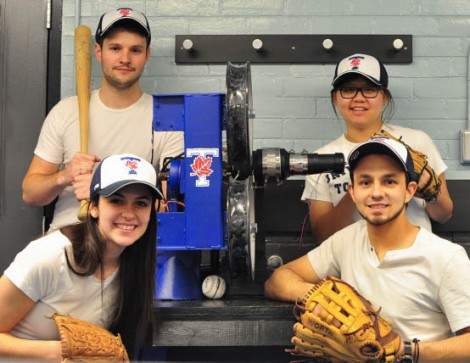This summer, four U of T mechanical engineering students created their very own “knuckleball machine.” The idea to design and build this machine was introduced by Professor David Sinton, a baseball fan and enthusiastic mechanical engineer.
The team, which consists of Queenie Yuan, Martin Cote, Alex Gordon and Jessica Tomasi, put all their efforts to crack the mystery of the knuckleball pitch. The reconstruction of this pitch is especially challenging due to the lack of rotation during the ball’s flight — according to scientific research, aerodynamic lift forces that act on the ball in the absence of rotation can fluctuate and cause zigzagging. This causes the ball to experience turbulence, and its trajectory becomes unpredictable. This effect does not happen in other types of pitches where the ball spins.
The team has had to solve two main problems: how to orient a baseball in the same way each time and how to closely regulate its spin.
The students’ research showed that behaviour of the pitch is very sensitive to the initial condition of throw. “What we discovered was that despite our best efforts to control the way the ball interacted with the machine, the level of control required to duplicate this sensitive pitch was too high. Small defects on the ball’s surface, such as the scuffs left on it by the machine’s wheels, affected its flight,” said Tomasi. This explains why it is difficult to throw the ball with the same conditions twice — even a small scuff on the ball can cause aerodynamic lift forces to fluctuate. Even the vibration of the machine influenced the ball’s orientation and entrance into the wheels.
During the launch, a baseball reaches the wheels whose speed is precisely tuned to set a specific amount of spin on the ball. “These features give our machine the ability to throw low-spin pitches that break in unpredictable directions every time,” Tomasi added.
The team started the project with literature and market research, and took eight months to complete the machine.
Despite the many challenges that the students faced during the design and fabrication process, many of them were overcome by method of trial-and-error. “Given more time and resources, and with what we know now, the machine would probably look very different.” Tomis said. She also explained that in order to test there , the students ended up spending many late nights late on campus to take advantage of the empty engineering building.
The team believes that the machine could potentially aid in training both hitters and catchers. The students said that a number of baseball coaches, team managers, players, and enthusiasts helped them in their research, and that most of their motivation was drawn from the Blue Jays’ R.A Dickey. They plan to work on the machine this summer and have it all ready for batting practice in September.


